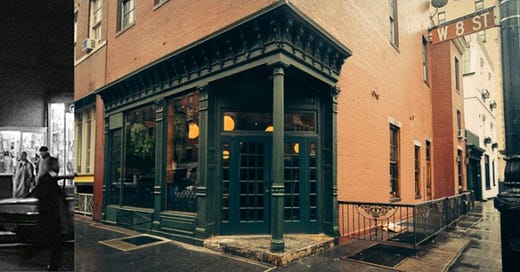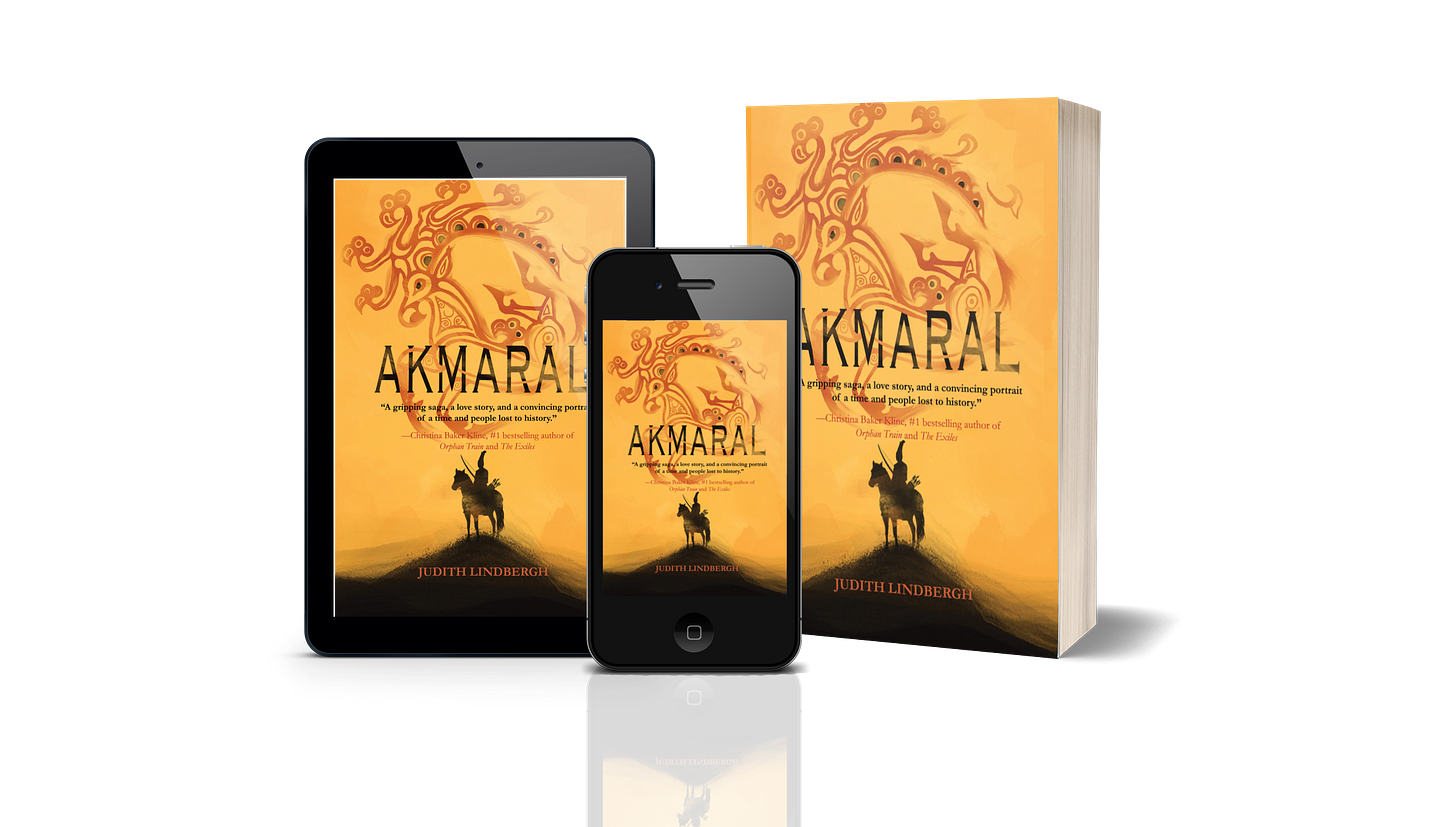Temporal Close Encounters, Book Adaptations, Publishing Then and Now, Farewell to the Book Tour
Plus a creative writing prompt about space-time, sort of....
Over the holidays, I discovered something I probably should’ve been aware of ages ago. My old apartment on West Eighth Street in Greenwich Village was mere yards away from one of the most iconic literary haunts in New York City, the 8th Street Bookshop. I moved there in the 1980s, at a time when proximity to the dancewear store on MacDougall was far more important to me. But just a few years before, that shop had been a literary hub, especially for Beat Generation writers and poets, among them W.H. Auden, Allen Ginsberg, and E. E. Cummings. The bookshop closed down in 1979. I had missed it by half a decade.
But I should have known that it had been there—if I had recognized where life would take me. When I lived in the neighborhood, the former bookstore was a cafe where we’d grab coffee before heading off to auditions or temp jobs. Why didn’t I sense that something even more remarkable had once resided in that space? Who would I have been had I arrived a decade or so sooner?
Of course, I know that I wouldn’t have existed or been far too young to care, but that’s beside the point as I ponder the essences of those who have walked through the same spaces as I. Perhaps the force of time is spurring these memories, as always happens for me at the turning of a new year, but I can’t help but wonder at all the temporal elbow-brushing and almost-encounters that shape or don’t shape our lives.
The Book Is (Almost) Always Better Than the Movie
My son recently read DUNE by Frank Herbert, a novel that his father has adored for decades. (It was required reading when we were first dating—a mind-opening revelation for this literary snob.) “You’re right, Dad. The movies don’t capture it at all.”
You would think that actors, sets, and special effects would bring added dimension to the silent, page-turning experience. But there’s something that words on a page capture that few dramatizations achieve. The layering of carefully woven plotlines and deeply drawn characters are often flattened when fit into a multimedia package. We lose the philosophical complexities and rich interiority that make a novel so much more. Or maybe it’s simply that our imaginations are more powerful than anything that can fit on a stage or screen, no matter the size?
There are countless novels that I thought were far better than their adaptations, starting with THE WORLD ACCORDING TO GARP, which I saw in the middle of reading the book, timing that ruined both experiences for me. I read PACHINKO recently enough to recognize some missing threads and convoluted chronology in the 2022 Apple TV production—not so well that I couldn’t enjoy the series, though I spent a lot of time explaining to my husband what the TV version missed, a habit he finds understandably annoying. I hesitated before starting ONE HUNDRED YEARS OF SOLITUDE on Netflix this week because reading the novel changed my perception of how reality could work, not only on the page, but in life itself. Last night we watched the first episodes, which were well done and engaging. But so far the critical magic realism is lost except for a ghost who haunts the family in episode one.
There’s only one film that I honestly consider far better than the book. It’s a very old and obscure one called NEVER CRY WOLF. Based on a “true story” by Farley Mowat about a government biologist sent to the Canadian Arctic to study declining caribou herds, the book was widely criticized for spreading fiction as fact. But what I disliked about the book was Mowat himself, whose self-portrait was grumpy and arrogant in equal measures. The main character in the film, portrayed by Charles Martin Smith, was far more vulnerable and ultimately open to his humbling journey beyond science into spirit. To this day, NEVER CRY WOLF informs my worldview and my writing in countless ways.
READ THIS If You’re Trying to Figure Out Publishing
After almost a year of promoting AKMARAL, I have come to some realizations about the realities of modern day publishing. While I won’t belabor them here, I will reveal some of them in my workshop, Book Marketing Boot Camp, which I’m teaching again this winter. To reinforce my anecdotal experience, over the holiday, I read Michael Castleman’s candid assessment of book publishing, past to present, The Untold Story of Books: A Writer’s History of Book Publishing. For the uninitiated, as well as those in the trenches, it may come as a shock to learn that authors have never wielded the large end of the literary stick. We are the producers, busy bees whose long hours and deepest creative impulses go into ever word you read, but the sweet, golden honey of our labors has almost always been harvested to benefit of others.
The End of the Road for my Official Book Tour
I am grateful, but also melancholy, to put my book tour to rest. It’s been quite a year of events and adventures. From the official launch at the Millburn Library in New Jersey to my last in-conversation at the Miami Book Fair, it’s been breathtaking to see how AKMARAL has drawn so much praise, as well as interest in a place and time that few knew existed.
Some highlights:
Finally giving my beloved Writers Circle community something to prove that I am a writer who writes as well as teaches.
Amazing in-person events and podcast conversations, including with bestselling novelists Christina Baker Kline, Cathy Marie Buchanan, Caroline Leavitt on The Mighty Blaze, and so many more.
Publishing lots of essays, including a piece about AKMARAL for the one of the Smithsonian’s academic newsletters—probably the smallest readership of any of my recent publications, but among the greatest honors of my career.
Making new writer-friends who shared promotional efforts, emotional support, and a well-placed table stacked with only slightly damp books at the very rainy Brooklyn Book Fair, among them Carol LaHines, Kerri Schlottman, and Crissa Jean Chappell. And sharing this and more with my dear literary big sister who’s been beside me from the beginning of my writing life, Stephanie Cowell.
I got to meet people in person I’d only emailed or Zoomed with before, including Kathy MacKay who won my giveaway coaching session at the beginning of this newsletter. I spent a wonderful weekend in Vermont, hosted by my friend Bambi Koeniger who wrangled together a lovely crowd for my talk at The Norwich Bookstore, after which my husband and I went hiking, of course!
You never know what small efforts create ripples in your life. But meeting people and sharing my passion for writing, ancient history, and one particular powerful woman of the past, have been the most satisfying parts of my literary life.
My final event, until further notice:
January 28, 2025: VIRTUAL EVENT, 7PM ET: Author Judith Lindbergh on Her Novel “AKMARAL”, hosted by the Ashland Public Library, Ashland, MA
And the audiobook should launch on January 7. You will probably get a quick message from me when it goes live. I hope you’ll grab a copy and listen!
Creative Writing Prompt: Temporal Crossings
As I mentioned above, I’ve been thinking about my own existence in both time and space—space-time, but in a literary sense, if you will. As the sun sets on the second to last evening of a momentous year filled with joy, opportunities, successes, but also many ominous things (most of which are completely out of my control), I cannot help but wonder about the energy that I put into the world and where that burst of vitality goes after my passing.
THE PROMPT: Consider yourself or a character physically crossing the path of an important person or incident from the past. It can be someone who is historically significant or any person at all, whether connected to the point-of-view character or completely unfamiliar except for this temporal exchange. Think of this as more than walking in their footpath. Try to feel the other character’s presence as if they’re still there. I prefer not to approach this exercise as an encounter with ghosts so much as with beings still vital and alive in their own moment in time, if only we can sense them.
This prompt reminds me of NORTH WOODS by Daniel Mason, another book I finished recently. In that brilliant novel, a rural Massachusetts house is the container for generations of souls, living and dead. They interact and are “present” within the confines of the house, surrounding orchard and woods, maintaining a continuity that links the characters and occasionally allows for connection, intentionally, consciously, or not. Perhaps we are always walking through the shadows of those that have passed this way before. Does that affect the way we think or feel? Is there communication through those essences?
Food for thought and writing as we drift out of the darkness of 2024 and into the light of whatever is to come.
Thank you, everyone, for your support. And to my paid subscribers, you are ANGELS!
AKMARAL: a nomad woman warrior of the ancient Central Asian steppes must make peace with making war
“A crackling novel”—Publishers Weekly | “A gripping saga”— #1 bestselling author Christina Baker Kline
4.8 stars on Amazon | 4.4 stars on Goodreads - PLEASE ADD YOUR OWN REVIEW!
Follow me on Instagram, Facebook, Threads, GoodReads, and Bluesky. (I'm off of Twitter/X now completely.) Or visit judithlindbergh.com.








Have a wonderful New Year creatively and in all other ways!
Some books are better than the film - I learned so much about baseball from Moneyball (the book) but the film just dealt with the personalities and dramas. On the other hand, I thought The Lord of the Rings films were superior to the books because Jackson cut out of bunch of extraneous materials, such as Tom Bombadil and the bad Elvish songs.